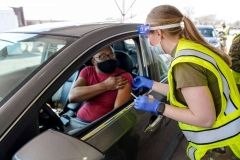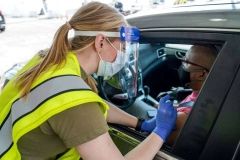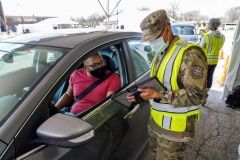![]()
Press release from the Indiana State Department of Health:
State Health Officials Release Final 2009-2010 Influenza Surveillance Report
(INDIANAPOLIS – May 7, 2010) – This week the Indiana State Department of Health released its final influenza (flu) surveillance report for the 2009-2010 flu season. This weekly report provided local health departments, hospitals, and doctors with an in depth understanding of flu activity in Indiana and helped guide clinical practice and community efforts, including vaccine distribution. To date, more than 1.3 million H1N1 vaccinations have been given and recorded into the Children and Hoosiers Immunization Registry Program (CHIRP) database.
“As the official flu season comes to a close, I am cautiously optimistic that we have avoided a third wave of the 2009 H1N1 flu pandemic,” State Health Commissioner Gregory Larkin, M.D said. “However, we don’t know what to expect in the upcoming months, so I still urge people to get the H1N1 flu vaccine, especially if you have a chronic medical condition.”
Some highlights from this week’s flu surveillance report include:
- The percentage of patients who visited Indiana emergency departments this past week with influenza-like illness was 1.0%; this is compared to a high of 12.7% during the week of October 18, 2009.
- There was one confirmed influenza-related death reported during Week 17, 2010 (the individual had underlying medical conditions; influenza virus subtype was not determined). There have been a total of 43 influenza-related deaths reported since June 1, 2009, of which 39 had confirmed 2009 H1N1.
- Since September 1, 2009, 98.4% (478/486) of specimens that were positive for influenza were 2009 H1N1, and 84% of the 2009 H1N1-positive specimens submitted have been collected from persons 0-24 years of age.
- According to CHIRP data, 29.6% of the estimated number of “high risk” persons in Indiana (i.e., pregnant women, health care providers, young children, persons with chronic medical conditions) have received the 2009 H1N1 flu vaccine.
- Of the 322,765 children, 6 months-9 years of age, who received at least one dose of 2009 H1N1 vaccine, only 107,777 (33%) have received the recommended two doses. Two doses are recommended to provide the best protection against 2009 H1N1 in this group.
“I applaud the outstanding work our local health departments did in getting the H1N1 flu vaccine out to the public,” Dr. Larkin said. “And, I would also like to thank the private physicians, hospitals, pharmacies, schools, colleges and universities, businesses, and faith-based organizations who worked alongside us throughout the flu pandemic. I have no doubt many lives were saved because we pulled together so well as a state in our response.”
Although the official 2009-2010 flu season is over, state health officials say that flu surveillance will continue year round to keep an eye on 2009 H1N1 and other types of flu. Additionally, they stress that all Hoosiers continue to get the seasonal flu vaccine every year. According to the Centers for Disease Control and Prevention, the flu vaccine this upcoming fall will provide protection against both the H1N1 virus and seasonal flu, so only one dose is needed for most individuals.
“I wish I could tell you what will happen during the next traditional flu season. We will share information with the public as it becomes available. In the meantime, I remind everyone to be sure to get a flu vaccine next fall to protect yourself and your family against H1N1 and seasonal flu,” Dr. Larkin said.















